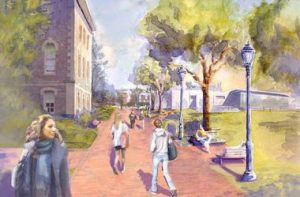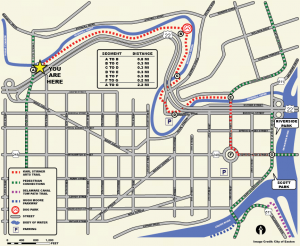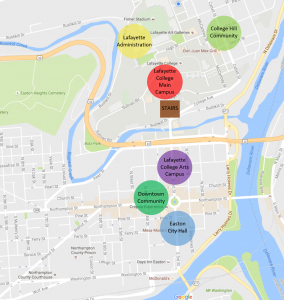Policy Analysis (Stairs)
In the process of analyzing the problem and developing a solution, we found it necessary to consider relevant policies and political contexts surrounding the problem of access between campus on College Hill and the downtown communities. The team considered three primary policies, Lafayette College’s Master Plan, Easton’s Comprehensive Plan, and the Karl Stirner Arts Trail Mission Statement as they not only provide guidelines for addressing projects like the Art Stairs but also highlight the goals and values of the involved communities. The politics of individual stakeholder positions were also considered through community mapping. The study of both policy and politics revealed that diverging perspectives have led to inactivity and projects that do not fully encompass the shared goals of community members, which provides further support for our proposed solution.
Lafayette College’s Master Plan:

Any decision made on college property must agree with the goals and institutional strategies highlighted in Lafayette College’s Master Plan. The plan, published in 2009 through the coordinated efforts of students, faculty, and administration, outlines a conceptual schedule for future construction based upon 4 guiding principles. These principles outline the college’s desire to “strengthen the identity of the campus by reinforcing the portals and edges,” “enhance college-community gateways,” “enhanc[e] network[s] of pedestrian paths,” and to “accommodate future new construction”. The egress of the stairs at the intersection of Third Street and College Avenue is both a visual statement of the college’s identity and a physical transition between the College Hill Campus, the Williams Arts Campus, and the Downtown community. The stairs are therefore essential to creating a unified identity between Lafayette academic departments and to strengthening the ties between the Easton community and the college. As an artery between the college and both I-78 and Route 22, the North Third Street entrance also serves as a greeting for tourists and College visitors. The third Master Plan principle stresses the importance of pedestrian paths, which must include the stairs as they currently serve as the most direct pedestrian thruway between campuses. Considering the continued development of campus facilities downtown, the stairs must also be considered as a component of the fourth principle’s discussion of accommodation for future construction. These four principles therefore not only directly impact decisions made about the stairs between campus and North Third Street, but also indicate that this project should be a priority in the college’s construction agenda. (Lafayette College, 2009)
Reading beyond the guiding principles, the Master Plan highlights several other values and goals that impact aesthetic designs for stair renovation. These include promoting a “green and natural aesthetic landscape across campus”, a factor largely neglected on the slope of College Hill that faces Third Street where brush, weeds, and poison ivy dominate the area. Our design incorporates measures to address this lack of aesthetic appeal while promoting a “natural” atmosphere lacking in other suggested designs. The Master Plan also stresses the need for downtown designs to be “aesthetically appropriate and compatible with adjacent buildings or street-scapes.” We will closely adhere to this statement as our design involves preserving historic components of the stairs, integrating artistic elements similar to downtown sculptures, and remaining sensitive to surrounding historic architecture. (Lafayette College, 2009)
Easton’s Comprehensive Plan:
The Comprehensive Plan, last published in 1997 and currently under revision, outlines community goals and values that should be considered in making alterations to a space that is not only visually prominent in the city but is also a part of pedestrian transit between city neighborhoods. The latter concern relates directly to the Comprehensive Plan’s emphasis on transportation. The plan asserts that Easton will strive to “adapt and reuse critical sites at the seam of neighborhoods,” “integrate Delaware and Lehigh Rivers, and Bushkill Creek with upland communities through a connected system of pedestrian, bike and open space networks,” and to “manage parking and promote sustainable transportation” (Urban Matrix Architecture and Planning & Metropolitan Urban Design Workshop, 2016, p. 32). Our proposed solution supports these goals as it revitalizes existing infrastructure, improves pedestrian access, and features limited fossil fuel consumption.
KSAT Mission Statement:

While not directly essential in the development of a solution to physical access between communities, the Karl Stirner Arts Trail (KSAT) represents an integral influential force in our goals of increasing the appeal of using the stairs and of strengthening connections to the community. We therefore considered the mission statement for the KSAT as a guiding principle in our own designs. The mission statement’s emphasis on reintroducing nature, “partnership with the diverse communities that vitalize Easton,” and civic engagement are shared by the proposed Art Stairs. The KSAT’s connection to the community, through its ties to the growing community of artists (E. Kerns, Personal Communication, November 1, 2016) as well as its ties to the college, through initial financial support and collaborative projects (D. McAteer, Personal Communication, November 2, 2016), make it an archetype for future town-gown relationships. The location of the stairs at the Third Street entrance to the KSAT, reinforce this ideological connection with a physical connection.
Political Context:
Given these three converging sets of goals and values along with the diverse communities they represent, we chose to consider the political contexts of the project through community mapping. Through interviews, surveys, and reviews of past statements, we have collected information about the various perspectives on the problem and proposed solutions in order to better understand how to develop a solution that addresses the needs of multiple stakeholders. While our process did not work to develop a physical representation of communities with participants, we ultimately used the idea of a map as a conceptual organization of varying perspectives based on geographical and political orientation. In this way, we were able to “give voice to […] participants, while also complicating simple notions of ‘community’” (Parker, 2006). Understanding that there is divergence between goals of those in administrative positions, faculty positions on College Hill, faculty positions on the Arts Campus, the neighborhoods within Easton, and the student population is essential to promoting inclusivity and connection.

While this community mapping approach contrasts previous approaches to the problem, it does not solely account for reasons why past projects have failed to incite administrative action. As noted in our introduction, a diverse set of stakeholders has a vested interest in the problem (Introduction). However, this salience has failed to instigate investigation until recent investment in the elevator project. Reasons for past inaction have been justified through concerns about technical and economic feasibility. Mary Wilford-Hunt, Director of Facilities Planning and Construction, discussed the physical complications of addressing the slope in our interview with her on October 14, 2016:
“It’s challenging because it’s a lot of work—a lot of steps. And it’s also very difficult to get materials or equipment on that steep slope. So what would be minor repair in another case becomes a logistical challenge.”
These physical challenges primarily translate into economic concerns. However, given that 9.5 million dollars are to be invested in an elevator project, it becomes clear that the hesitation surrounding stair reconstruction expands beyond monetary concerns. In an interview with Lehigh Valley Live, President of the college Allison Byerly remarks that the college sees the elevator “as potentially […] very valuable, a signature aspect of the town that will set it apart” (Miller, 2016). This idea of a solution to the problem of access as an opportunity for the college to create a statement piece aligns with Lafayette College’s Master Plan’s principle of making the college “a memorable place” (Lafayette College, 2009, p. 5). However, the scale of investment in the solution over a less costly renovation of the stairs (Economics Analysis) is at odds with Byerly’s statement that they are attempting to “conserve the college’s resources and devote more of them to supporting students” (Miller, 2016). Much of the controversy surrounding the discussion of an elevator stems from an understanding of opportunity cost. In an interview with The Lafayette, Easton Mayor Sal Panto indicates that he believes the project is a “waste of money” compared to other methods of addressing the commuting situation (Morse, 2016). This view of the 9.5 million dollar investment as limiting in its ability to provide diverse benefits has not been publicly acknowledged by the Lafayette administration.
It is also important to analyze reasons for investment in the elevator project at this moment in the college’s history. Over the past several years, the college has invested over 20 million dollars towards developing the downtown William’s Arts Campus (Merlin, 2016). However, no plans to address commuting issues were announced until August of 2016 (Byerly, 2016), after plans to move 85 administrators to the former Alpha Building were underway. Film and Media Studies Program Chair Andy Smith refers to this move as “a tipping point” in addressing the problem and notes his uncertainty over whether or not the connection to the arts campus would have been transformed into action without it (Personal Communication, October 24, 2016). Art Department Professor Ed Kerns discusses his thoughts on the motivations behind pursuing this particular project over other less expensive ideas:
“I think they’re going for the ideas that best suit persons on the board who might donate money to it. That’s always the case. I mean if I asked for money for more paint and they developed a need for someone to give us more computers, we’ll get more computers […] because that’s where the money is.” (Personal Communication, November 1, 2016)
While the college’s spending on the arts campus reflects its investment in the arts (A. Smith, Personal Communication, October 24, 2016), Professor Kerns’ commentary reflects the prioritization of technological investment. His statement also reflects Maurrasse’s assertion that “[collegiate] institutions also are becoming increasingly corporate in nature” (2001, p. 11). Understanding the economic motivations and opportunities is essential for understanding the history of the project as well as for developing paths forward.
An understanding of how the problem is defined by various stakeholders is also essential to understanding desired outcomes and reasons for past inactivity. One of the major points of controversy that emerged from our discussions was the lack of ADA compliance in commuting options between downtown and College Hill. The stairs as they exist do not meet compliance standards which require ramps sloping no more than 1:12 (Guldman) and continuous handrails on both sides of the path (United States Access Board). In the 2014 Engineering Studies Capstone project, an interview with Mary Wilford-Hunt indicated that a campus wide ADA evaluation was being conducted. The evaluation is now at its final stages of revision and is being used to “systematically address projects” (Personal Communication, October 14, 2016). She asserts that she and the rest of Facilities Planning and Construction “are always looking for opportunities when we are doing more work […] [to] effectively address ADA issues (M. Wilford-Hunt, Personal Communication, October 14, 2016). While no specific mention of making the stairs ADA compliant was made, these statements do indicate a broader trend in Lafayette College’s construction.
Asking City Planner Dave Hopkins about whether he thought ADA compliance was a priority in the solution to this issue indicated a different viewpoint. When asked how he would rate the importance of ADA compliance in the stair solution on a scale from 1 to 5 with 1 being very unimportant and 5 being top priority, he indicated that compliance was “just impossible” and rated its priority a 1 (Personal Communication, October 26, 2016). Art professor Nestor Gil asserts that the issue of access for those with disabilities is of “dire importance” (Personal Communication, November 7, 2016). However, he does not see this particular portion of the problem as a key component for the stair design noting that “the questions about how the stairs could be made to accommodate seems to me like a question that’s built to sort of throw the stairs under” (N. Gil, Personal Communication, November 7, 2016). The consideration of ADA compliance as part of the problem presents significant changes to addressing the issue and can therefore be understood as an obstacle in past discussions. However, given that other provisions, such as the LCAT shuttle and Public Safety, are available for people with disabilities, we do not consider this to be a constraint in our solution. Furthermore, while the elevator does bypass the most difficult portion of the slope, many of the paths on College Hill still remain inaccessible to wheel chairs due to slope and terrain.
After receiving feedback on problem definition, we investigated what stakeholders would like to see in a solution. A variety of recommendations were given, including Mary Wilford-Hunt’s suggestion of a shuttle incentive program (Personal Communication, October 24, 2016) and Ed Kern’s proposition of a restaurant on the stairs (Personal Communication, November 1, 2016). However, most suggestions revolved around previously considered solutions such as Jim Toia’s recommendation of better lighting and consistent stair height (Personal Communication, October 24, 2016), Dave Hopkin’s suggestions to lessen slopes, address railing issues, and make it a maintenance priority, and Nestor Gil’s suggestion of placing park benches at each landing. Both Ed Kerns and Dave Hopkins expressed their desire to see better lines of sight through improved landscaping. The idea of providing incentives along the commute through art installations has the potential to entice College Hill residents to visit the downtown community. If the commute were to be a destination in itself—“a place to be” in the words of Nestor Gil, then the other downtown destinations may be made more appealing. Eliminating barriers between Lafayette College students and the downtown community will facilitate pedestrian traffic and investment in local businesses. In order to raise support and develop ownership of this issue, we believe that it is necessary to document and consider all of these inputs in design (Introduction).
Perhaps the most neglected consideration in past and current projects is the understanding of who the client is. As noted in the Social Context section (Social Analysis), the issue of town-gown relationships is widely recognized in discussions of physical links between Easton and Lafayette College. However, the proposed elevator design fails to consider how to make the commute more appealing to communities beyond the students. Historically, colleges and universities have succumbed to this campus-centric model in which the focus is placed on “increasing student access to community resources” (Bruning, McGrew, & Cooper, 2006, p. 126). Mayor Sal Panto describes one of his concerns regarding the elevator solution in his statement that “looking at where it comes out on the campus, I don’t see neighbors using it” (Morse, 2016). The elevator is planned to connect the area behind South College to Bushkill Drive, providing a singular entrance to the campus versus the three-point entrance provided by the proposed stair system at Easton Hall, South College, and Simon Hall. Furthermore, Nestor Gil expresses his personal belief that the student space surrounding the dormitories should be left to the students, leading him to prefer the Simon Hall entrance to the stairs (Personal Communication, November 7, 2016). With these comments in mind, solutions that are grounded in a Lafayette-biased problem definition must be considered critically.
Through this analysis of the problem’s evolution and growing presence throughout the college’s and City’s growing relationship, it is clear that the proposed Art Stairs coincide with the goals of both the Lafayette and Easton communities by addressing safety concerns and increasing the appeal of using the stairs through art. Even more important to this solution is the continued involvement of stakeholders in order to increase a sense of “personal investment,” which is recognized as “an important contributor to a person’s […] sense of community” (McMillan & Chavis, 1986, p. 10,). If moved into the administrative agenda, this project will require coordination with local artists, networking with downtown bookstores and libraries, and additional trans-neighborhood interactions that will strengthen both physical and symbolic connections between communities.
